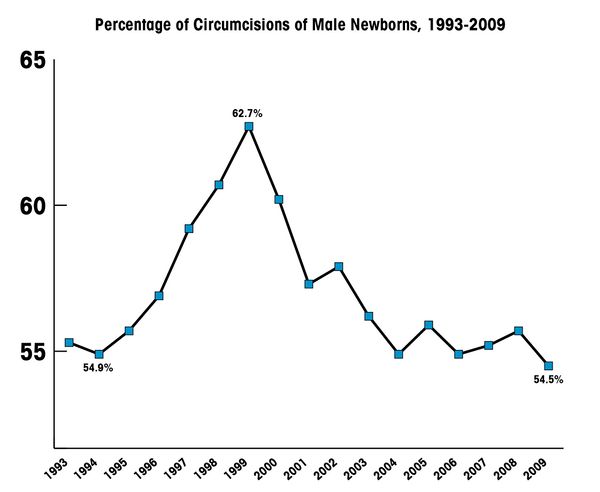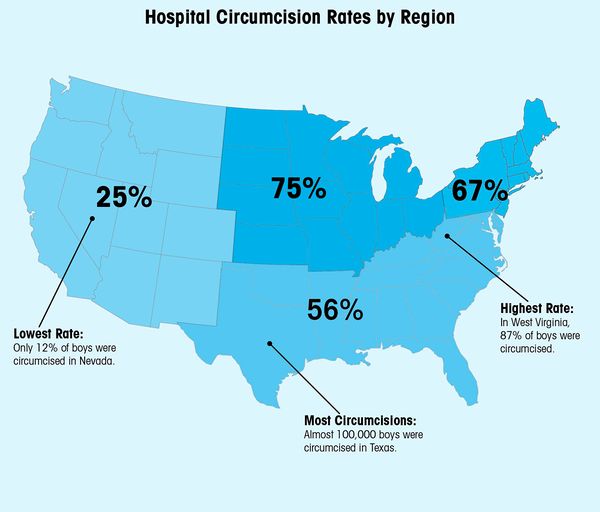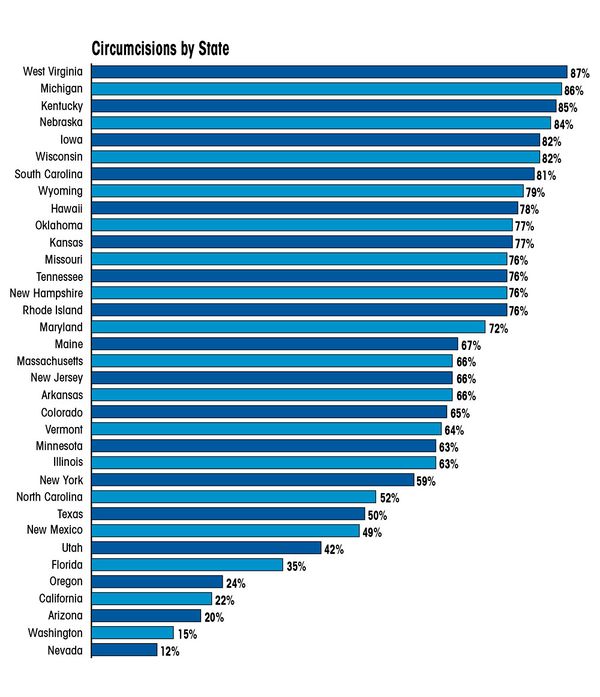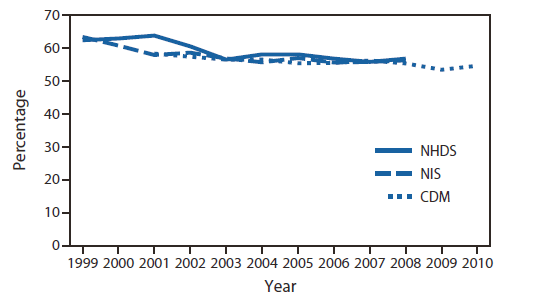Circumcision prevalence
Construction Site
This article is work in progress and not yet part of the free encyclopedia IntactiWiki.
Contents
The United States of America
According to Wallerstein, the rate of male circumcision in the U.S. may have been around 10% in 1880, when it was just beginning to become legitimized as a medical procedure, and grew in popularity steadily until it's peak in the 1980's.[1] According to the American Medical Association's most recent major document on medical circumcision, the "Report 10 of the Council on Scientific Affairs", created by their "Council on Science and Public Health" in 1999, the prevalence of circumcision in the United States increased from about 30% in the 1930s to nearly 80% by the early 1970s".[2] Current reports estimate the rate of adult circumcised American men at approximately 80%.[3]
H-CUP 2009 statistical brief
The following graphs represent data from a statistical brief released by the Healthcare Cost and Utilization Project (H-CUP).[4]
2011 CDC report
According to a CDC report released in September 2011, male infant circumcision is on a downward trend. The rates of in-hospital infant circumcisions had increased from 48.3% during 1988--1991 to 61.1% during 1997--2000. They estimated infant circumcision rates during 1999--2010 using three independent data sources (the National Hospital Discharge Survey [NHDS] from the National Center for Health Statistics, the Nationwide Inpatient Sample [NIS] from the Agency for Healthcare Research and Quality, and the Charge Data Master [CDM] from SDIHealth).[5]
The figure above shows the incidence of in-hospital newborn male circumcision, by data source, in the United States during 1999-2010. Incidence of newborn male circumcision decreased from 62.5% in 1999 to 56.9% in 2008 in the National Hospital Discharge Survey (average annual percentage change (AAPC) = -1.4%; p<0.001); from 63.5% in 1999 to 56.3% in 2008 in the Nationwide Inpatient Sample (AAPC = -1.2%; p<0.001); and from 58.4% in 2001 to 54.7% in 2010 in the Charge Data Master (AAPC = -0.75%; p<0.001).
Abbreviations: NHDS = National Hospital Discharge Survey; NIS = Nationwide Inpatient Sample; CDM = Charge Data Master.
Conflicting report
One year earlier, at the AIDS 2010 Vienna conference, CDC spokesman Charbel El Bcheraoui delivered a presentation on circumcision complications,[6] in which a study noting a steep drop in the neo-natal circumcision from 56% to 33% was presented.[7] This is a sharp contrast from the 55% figure the CDC is currently releasing. The CDC disowns the 33% figure,[8] asserting that it was based on calculations by SDI Health, a company in Plymouth Meeting, PA that analyzes health care data, and was not definitive. Andrew Kress, the chief executive of SDI Health, cautioned that the data had not yet been published and was still being analyzed.[9]</ref> Both SDI and the CDC confirmed that the trend had been toward fewer circumcisions each year, adding that measuring the circumcision rate was not the purpose of the study, which was designed to measure the rate of complications from the procedure.[10]
Global prevalence
References
- ↑ Wallerstein, Edward. Circumcision: An American Health Fallacy. Springer, New York. 1980. pp. 217
- ↑ "Report 10 of the Council on Scientific Affairs (I-99): Neonatal Circumcision". American Medical Association Official Website. http://www.ama-assn.org/ama/no-index/about-ama/13585.shtml. Accessed May 4, 2011.
- ↑
 Rabin, Roni Caryn (16 August 2010)."Steep Drop Seen in Circumcisions in U.S.". Retrieved 24 September 2011.
Rabin, Roni Caryn (16 August 2010)."Steep Drop Seen in Circumcisions in U.S.". Retrieved 24 September 2011.
Quote:Some 80 percent of American men are circumcised, one of the highest rates in the developed world.
- ↑ Maeda, J. (Thomson Reuters), Chari, R. (RAND), and Elixhauser, A. (AHRQ). Circumcisions in U.S. Community Hospitals, 2009. HCUP Statistical Brief #126. February 2012. Agency for Healthcare Research and Quality, Rockville, MD. http://www.hcup- us.ahrq.gov/reports/statbriefs/sb126.pdf
- ↑
 Bcheraoui, Charbel El; with Xinjian Zhang, Sanjyot Shinde, Peter H. Kilmarx, Robert T Chen, Maria Owings [deprecated REFjournal parameter used: <coauthors> - please use <last2>, etc.]. Trends in In-Hospital Newborn Male Circumcision --- United States, 1999--2010. Morbidity and Mortality Weekly Report (MMWR). 2 September 2011; 60(34): 1167-1168. Retrieved 24 September 2011.
Bcheraoui, Charbel El; with Xinjian Zhang, Sanjyot Shinde, Peter H. Kilmarx, Robert T Chen, Maria Owings [deprecated REFjournal parameter used: <coauthors> - please use <last2>, etc.]. Trends in In-Hospital Newborn Male Circumcision --- United States, 1999--2010. Morbidity and Mortality Weekly Report (MMWR). 2 September 2011; 60(34): 1167-1168. Retrieved 24 September 2011.
Quote:Incidence of newborn male circumcision decreased...
- ↑ Rates of selected neonatal male circumcision-associated severe adverse events in the United States, 2007-2009: , XVIII International AIDS Conference July 18-23 2010 Vienna Austria, Charbel El Bcheraoui; J. Greenspan, K. Kretsinger, R. Chen, Publisher: International AIDS Society, Vienna, Austria (18 July 2010). Retrieved 24 September 2011.
- ↑ US newborn male circumcision rate dropped sharply in from 2006 to 2009: Quote:
Circumcision rates fell from 56% in 2006 to 33% in 2009.
, AIDS 2010, Vienna, Austria, Mitchel L. Zoler, Publisher: Elsevier Global Medical News, Vienna, Austria (5 August 2010). - ↑
 Rabin, Roni Caryn (16 August 2010)."Rabin". Retrieved 24 September 2011.
Rabin, Roni Caryn (16 August 2010)."Rabin". Retrieved 24 September 2011.
Quote:C.D.C. was not involved in the collection of the data that was cited, nor has C.D.C. undertaken any review of this particular data for the purpose of calculating rates...
- ↑
 Rabin, Roni Caryn (16 August 2010)."Steep Drop Seen in Circumcisions in U.S.". Retrieved 24 September 2011.
Rabin, Roni Caryn (16 August 2010)."Steep Drop Seen in Circumcisions in U.S.". Retrieved 24 September 2011.
Quote:Andrew Kress, the chief executive of SDI Health, cautioned that the data had not yet been published and was still being analyzed...
- ↑
 Rabin, Roni Caryn (16 August 2010)."Steep Drop Seen in Circumcisions in U.S.". Retrieved 24 September 2011.
Rabin, Roni Caryn (16 August 2010)."Steep Drop Seen in Circumcisions in U.S.". Retrieved 24 September 2011.
Quote:What we can tell you is that male infant circumcision rates have declined somewhat in this decade...





